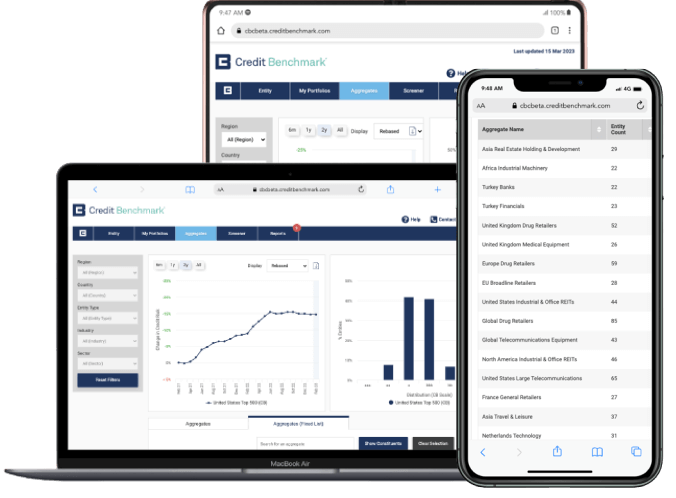IFRS 9 / CECL Impairment Bechmarking
Credit Consensus Data for Impairments Benchmarking
Under IFRS9 / CECL

Why Credit Benchmark?
Point-in-Time term structures provide comparability for the impairment process
In addition to “through the cycle” probabilities of default, Credit Benchmark also collects and aggregates Point-in-Time (PIT) PD curves from a growing number of global banks, allowing our clients to access a comprehensive set of consensus term structures at entity-, sector-, industry-, geographical level.
Leveraging the insights provided through the benchmarking outputs, clients are able to identify, justify and articulate the key drivers of variance in expected credit loss and provisions to both internal and external stakeholders.

Solutions
How we can help your business

Better understand key drivers of divergences of ECL to equip Investor Relations team to articulate Impairment comparisons.

Benchmark PIT PDs / Curves against peers to allow for identification of drivers of earnings volatility.

Track changes in Credit Consensus Ratings to bolster staging assessment process, compare internal staging assumptions against the consensus, and enhance view on unrated / LDP portfolios.

Optimize internal processes by identifying risk areas with largest relative / absolute PD movements, monitoring rating changes well before year-end, and improving connectivity and reconciliation between credit ratings, regulatory capital, and impairment.

Utilise benchmarking outputs to assess the impact of economic scenarios and weightings in impairment outcomes.
Case Study
The Client
The model validation team at a major UK-based Bank
The Challenge
The model validation team wanted to implement a robust model monitoring and validation framework for IFRS 9 utilising a representative independent dataset. They were also looking to help justify amendments to models and validation framework to auditors and regulators.
The Solution
Credit Benchmark’s Consensus Term Structures facilitated like-for-like benchmarking on an economically representative proportion of the bank’s portfolio. Independent and representative data allowed for tangible justification to internal and external stakeholders and formed a central part of their validation and monitoring framework.

In Numbers
Entities with Credit Consensus Ratings
Bond and Loan Rating Assessments, Representing $34+ Trillion Outstanding
Risk Observations Feeding Into Weekly Data Updates
Credit Risk Observations Collected Since Launch in 2015
Industry & Sector Indices
Countries Covered
Major Global Banks Contributing, Almost Half Are GSIBs
Credit Analysts Contributing Risk Views
Of Universe Unrated by Traditional Rating Agencies
Of Corporate Universe Are Private Companies
The Benefits of Consensus Credit Data

Rating the unrated
Unparalleled coverage of public and private issuers; filling the gaps left by traditional ratings agencies.

Independent
Free from “issuer-pays” conflict and any bank bias.

Real-world exposure
Driven by the credit views of >40 of the world’s largest regulated banks, almost half of which are GSIBs.

Identify that entity
Risk data is processed through a sophisticated purpose-built mapping engine.

Dynamic
The consensus is refreshed weekly to provide dynamic indicators of potential credit risk changes.

Alerting and monitoring
Assess risk over the lifetime of a transaction.

Secure reporting
Ease of internal integration within reporting.

Expanding footprint
A unique growing global dataset.











